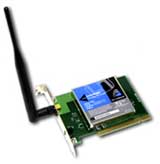I have to take a work break to whine about two things.
 First, the drivers for Linksys‘s WMP11 802.11b PCI wireless cards suck. I was banging my head against the desk at a client’s house for upward of half an hour with this card. I went to the client’s main computer and checked the web for solutions. I stumbled across a discussion forum thread at www.dslreports.com with the solution. The WMP11’s drivers added a registry key that loaded the card’s main .SYS driver from a CD! This means that unless you had the installation CD in the drive at reboot, the card was not going to work. Hacking the registry fixed this problem. Whew! I was afraid the client’s Windows XP install was corrupted!
First, the drivers for Linksys‘s WMP11 802.11b PCI wireless cards suck. I was banging my head against the desk at a client’s house for upward of half an hour with this card. I went to the client’s main computer and checked the web for solutions. I stumbled across a discussion forum thread at www.dslreports.com with the solution. The WMP11’s drivers added a registry key that loaded the card’s main .SYS driver from a CD! This means that unless you had the installation CD in the drive at reboot, the card was not going to work. Hacking the registry fixed this problem. Whew! I was afraid the client’s Windows XP install was corrupted!
Second, Microsoft‘s Web Folders technology is way too fragile, and when it breaks it is nearly impossible to get it working again.
In Windows XP, Web Folders is what you get when you go to My Network Places on the Start Menu. Any time you open a web site over HTTP in FrontPage, the opening action “passes through” Web Folders. If Web Folders gets corrupted, FrontPage can’t open web sites!
My XP’s Web Folders feature was so corrupted that even a Microsoft-endorsed 3rd party hack, Jimco Open Web, couldn’t open this web site!
So last night I reinstalled Windows XP, installed Office 2003 and its Service Pack 1, and installed Windows XP Service Pack 2. Argh, after all this work I still had the same problem! Even though this was a true reinstall, not simple a Windows “refresh,” the same problem still happens! I wonder if not deleting the Program Files tree is the problem?
Tonight I am going to disconnect my primary drive, make my slave drive my primary, and install Windows XP on the slave drive. That may make sense anyway since the slave drive is only about 2 months old. The primary drive is about 3 years old. Plus the slave drive has no Windows, Program Files, or any other traces of a Windows install. It just has backup files.
Back to making UML class diagrams for a project at work.
 .
. My Windows XP box is fully patched with all latest Windows Updates and Office Updates. The one thing I was lacking was the virus software. I had to redo my computer due to a hardware failure about two weeks ago, and I neglected to reinstall my virus scanner. It’s on now, and it caught the virus very quickly.
My Windows XP box is fully patched with all latest Windows Updates and Office Updates. The one thing I was lacking was the virus software. I had to redo my computer due to a hardware failure about two weeks ago, and I neglected to reinstall my virus scanner. It’s on now, and it caught the virus very quickly. I have a Compaq iPAQ 3970 PDA. It was given to me about a year and a half ago by SMU because we were going to write a PDA-based ticket writing software for the SMU police department. I wasn’t going to write the software, but as a web geek I was supposed to provide support and knowledge.
I have a Compaq iPAQ 3970 PDA. It was given to me about a year and a half ago by SMU because we were going to write a PDA-based ticket writing software for the SMU police department. I wasn’t going to write the software, but as a web geek I was supposed to provide support and knowledge.